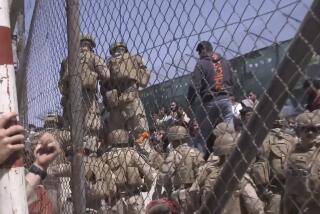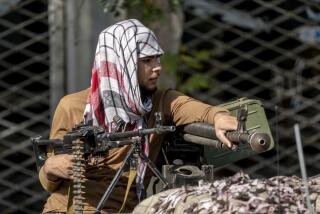19 die in apparent US airstrike on Afghan hospital
KABUL, Afghanistan _ The war in Afghanistan, at least for the United States, was supposed to be winding down.tmpplchld But an apparently errant bombing Saturday morning thrust the U.S. military back to the forefront of a conflict in Afghanistan that shows no signs of abating, and has demonstrated the risks of the Obama administration’s halfway approach to reducing the scope of a 14-year mission.tmpplchld U.S. military officials said an airstrike aimed at insurgents in the northern Afghan city of Kunduz shortly after 2 a.m. Saturday “may have resulted in collateral damage to a nearby medical facility.” That facility was a trauma center operated by the international charity Doctors Without Borders, which had 105 civilians and 80 medical staff inside.tmpplchld At least 19 people _ 12 medical staff members and seven intensive care patients, including three children _ were killed and 37 others were injured, the Doctors Without Borders said. The group said its facility was hit repeatedly over more than an hour and questioned how the hospital could have been struck after it had informed U.S. and Afghan military officials of the facility’s GPS coordinates several times in the past month, including just four days earlier.tmpplchld “This attack is abhorrent and a grave violation of international humanitarian law,” said Meinie Nicolai, president of Doctors Without Borders. “We demand total transparency from coalition forces. We cannot accept that this horrific loss of life will simply be dismissed as ‘collateral damage.’”tmpplchld Zeid Raad Hussein, the United Nations high commissioner for human rights, called the event “tragic, inexcusable and possibly even criminal.”tmpplchld “International and Afghan military planners have an obligation to respect and protect civilians at all times, and medical facilities and personnel are the object of a special protection,” he said. “These obligations apply no matter whose air force is involved, and irrespective of the location.”tmpplchld “While we are still trying to determine exactly what happened, I want to extend my thoughts and prayers to everyone affected,” Defense Secretary Ashton Carter said.tmpplchld Doctors Without Borders workers said the main hospital building _ housing an intensive care unit, emergency rooms and physiotherapy wards _ was “hit very precisely, while surrounding buildings were left mostly untouched.”tmpplchld The airstrikes continued for half an hour after the agency contacted military officials and informed them of the hospital’s position, staff said.tmpplchld “When I made it out from the office, the main hospital building was engulfed in flames,” said Heman Nagarathnam, the group’s head of programs in northern Afghanistan. “Those people that could have moved quickly to the building’s two bunkers to seek safety. But patients who were unable to escape burned to death as they lay in their beds.”tmpplchld The fallout from the apparent airstrike represents the scenario the U.S. military was trying to avoid in Afghanistan when it moved into a largely “noncombat” role starting in January, shrinking the American troop presence to 9,800 and narrowing their focus to advising Afghan forces.tmpplchld Under the new mission, the U.S. military can carry out airstrikes only to protect its own forces or in counterterrorism operations. The Obama administration hoped the rules would force Afghan troops, despite their dependence on the U.S.-led coalition for air power, to become more self-reliant while reducing the U.S. role and minimizing the risk of civilian casualties.tmpplchld Former Afghan President Hamid Karzai frequently railed against the U.S. for not doing enough to avoid civilian deaths. U.S. military officials have privately acknowledged that wayward airstrikes and violent raids in civilian areas help fuel support for insurgents.tmpplchld Through August the U.S. military had launched 523 airstrikes in 2015, one-third as many as in the comparable period last year. But as in previous years, the bombings increased over the summer as fighting increased and Afghan forces were unable to stop Taliban-led militants from making advances in the north, south and east of Kabul, the capital.tmpplchld The events of the past week have stretched the definition of “noncombat” and prompted Pentagon officials to argue that the withdrawal of more U.S. troops should be delayed.tmpplchld After the Taliban grabbed control of Kunduz on Monday _ the first time since the U.S.-led invasion in 2001 that they had seized a major Afghan city _ American forces conducted at least three airstrikes against suspected militants around the city of 300,000.tmpplchld On Thursday, as Afghan forces pushed the Taliban from Kunduz, U.S. special forces troops traded fire with insurgents inside the city, one of the first times this year that American service members were involved in direct ground fighting in Afghanistan.tmpplchld With sporadic fighting ongoing, a spokesman for coalition forces, Col. Brian Tribus, said the Saturday airstrike targeted “individuals threatening the force.” Carter said the area near the hospital “has been the scene of intense fighting the last few days” and that both U.S. forces and Taliban fighters were stationed nearby.tmpplchld The Doctors Without Borders hospital had treated nearly 400 patients since Monday and has a policy of caring for any injured person, even insurgents. The Afghan public health ministry said the damage “will have a major impact on the delivery of additional health services to the people of Kunduz.”tmpplchld ����tmpplchld (Latifi is a special correspondent. Bengali, a Times staff writer, reported from Mumbai, India. Staff writer W.J. Hennigan in Washington contributed to this report.)tmpplchld tmpplchld tmpplchld ___tmpplchld (c)2015 Los Angeles Timestmpplchld Visit the Los Angeles Times at www.latimes.comtmpplchld Distributed by Tribune Content Agency, LLC.tmpplchld
More to Read
Start your day right
Sign up for Essential California for news, features and recommendations from the L.A. Times and beyond in your inbox six days a week.
You may occasionally receive promotional content from the Los Angeles Times.






